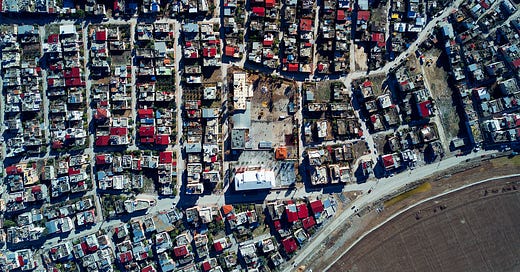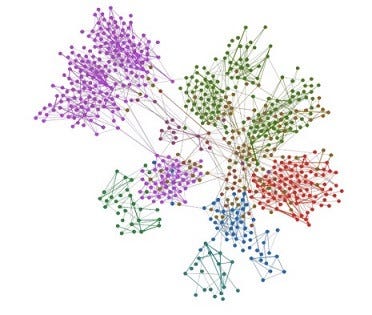Building Better Neighbourhoods By Strengthening Bonds and Bridges
#WF28 Using Organisational Network Analysis to build stronger teams plus some of the challenges that People Analytics needs to overcome

Today’s Workforce Futurist is brought to you by…Visier
To solve business challenges, the role of the Organisational Scientist is increasingly important. Visier is the People data and analytics Cloud that elevates employees—and businesses—to new heights. Their clients include 1 in 3 of the Fortune 500 from BASF to Panasonic and Experian.
Looking After The Neighbourhood
“I’ll dig a tunnel from my window to yours….”
Arcade Fire - Neighborhood #1 (Tunnels)
Think of the neighbourhoods you’ve most enjoyed living in.
What was it that you most liked about living there?
Growing up in the suburbs of South Manchester, my mum was a nurse. So any local kid who grazed their knee would knock on our door. People helped each other out where they could. The strength of the community was not the sum of the individual households, it was the strength of the relationships between them.
In organisations many of our management processes are designed around individuals and not the teams where the work is delivered.
Michael Arena (VP Talent & Development at AWS) shares a study on the impact of hybrid working on an engineering organisation with 700 individuals.
The researchers looked at bonding and bridging connections with different teams.
Strong bonding occurs when individuals are highly interconnected with one another - this enables a team to move quickly as one cohesive group.
Bridging exists when various groups are connected to one another and provides access to new and diverse information and insights.
Both are critical to an organisations’ long-term success.
During the early stages of the pandemic, this engineering organisation seemed to be functioning well with very strong bridging connections across the various functions.
This first network diagram demonstrates a dense set of bonding connections within the various functional engineering groups highlighted by the multiple colors of tightly connected individuals.
After a year of hybrid working, demonstrated in the second diagram, the researchers noticed that there was a reduction of bridging across the seven engineering functions. A decrease in bonding connections was also observed with splintering within some of these functions.
This analysis raises some questions about how we work, including how we build bridges between teams. Not every organisation has the size, skills, or technology to do this kind of study. However, it shows that by asking the right questions and trying new ways of working we can try and keep our organisational neighbourhood healthy.
You can read more about this study here.
And this article gives more information and examples on Organisational Network Analysis and the new Technology of Teams which I wrote with Francisco Marin.
Alternatively 🎼 get some musical inspiration from Arcade Fire.
Changing of the Guard
The pandemic has been a catalyst for spring-boarding a new type of leader into the important business decisions.
How do we maintain productivity?
How do we increase product innovation?
What is the impact of exiting a market?
Every important business challenge has an impact on the workforce. From M&A options to responding to industry restructuring, or rapid supply-chain changes.
HR leaders in larger organisations need to steer a multi-disciplinary team of analysts, strategists, specialists, and technologists.
People Analytics Maturity
A few years ago I wrote about some of the challenges that People Analytics needs to overcome. Visier did some research on People Analytics Maturity, where they surveyed 62 organisations and noted changes in adoption from 2018. For example, they reported a better impact on business outcomes that matter to the C-level, including profitability.
In their analysis, something caught my eye, which amplifies a trend :-
“serving people managers is the new focus of advanced organisations”
A key role for any HR function is to enable teams to make better people-related decisions. This means empowering them with the right tools and capabilities to do the job.
The two main challenges noted from their survey were :-
75% HR systems don't connect to important business results such as profit, customer satisfaction and revenue
69% We do not have a data-driven skillset within HR and / or our HR business partners
So what are the challenges that People Analytics need to overcome?
You can download the full Visier report here, The Age of People Analytics 2021 (sign-up required)
Challenges for People Analytics in 2022
Back in 2016, I wrote, Seven Challenges That People Analytics Must Overcome.
Where are we now? Here’s a quick take :-
We prefer ‘gut feelings’ to make people based decisions - my intuition tells me that this is still the case.
The Peak of Inflated Expectations - I imagine some orgs are still snuffling in the ‘trough of disillusionment’ but some have clearly climbed to the ‘plateau of productivity’.
HR Doesn’t Need Big Data – It Needs Big Questions - almost as if this was planned my recent article covers this topic - ‘Don’t Be Just Another Person With Data’
We Need The Right Tools for the Job - there has been massive investment in #WorkTech but our technology is completely inadequate for the organisational challenges we have. From 2016, see also “HR and Analytics: why HR is set to fail the big data challenge”. We need a new infrastructure for work which I suspect will be rebuilt from the bottom-up using digital career profiles.
No Confidence in the Underlying Frameworks - I’ll leave this one for my academic colleagues to answer.
Show Me the Money! 💲 Always.
Structural Issues with HR Operating Models – this was and is still the biggest problem :- ‘Work design’ capability is generally weak for the wider firm, and for HR itself. A skills gap caused by the re-badging of HR generalists into strategic HRBPs. Distraction caused by counter-productive vendor-led displacement activities like employee engagement 🍋 surveys.
There are still challenges for people analytics adoption. I don’t see an incremental adoption curve at all, but see it in the context of how organisations are changing.
Over time people analytics capability will be rolled-out to more self-sufficient teams with workforce technology. Activities of central corporate silo’s will melt away over the next decade, with some specialists remaining. See What Will Drive The Future of HR? (Spoiler Alert - It’s not ‘that book’ or an ‘Influencer List’).
People management capability, including people analytics tools, will largely be decentralised.
I would love your perspective on this - do write to me!








